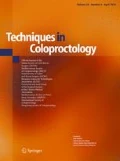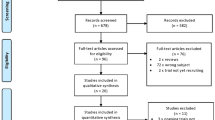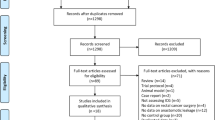Abstract
Background
Indocyanine green (ICG) fluorescence imaging has been proven to be an effective tool to assess anastomotic perfusion. The aim of this systematic review and meta-analysis was to evaluate its efficacy in reducing the anastomotic leakage (AL) rate after colorectal surgery.
Methods
PubMed, Scopus, WOS, Google Scholar and Cochrane Library were searched up to January 2017 for studies comparing fluorescence imaging with standard care. ClinicalTrials.gov register was searched for ongoing trials. The primary outcome measure was AL rate with at least 1 month of follow-up. ROBINS-I tool was used for quality assessment. A meta-analysis with random-effects model was performed to calculate odds ratios (ORs) from the original data.
Results
One thousand three hundred and two patients from 5 non-randomized studies were included. Fluorescence imaging significantly reduced the AL rate in patients undergoing surgery for colorectal cancer (OR 0.34; CI 0.16–0.74; p = 0.006). Low AL rates were shown in rectal cancer surgery (ICG 1.1% vs non-ICG 6.1%; p = 0.02). There was no significant decrease in the AL rate when colorectal procedures for benign and malignant disease were combined. To date, there are no published randomized control trials (RCTs) on this subject, though 3 ongoing RCTs were identified.
Conclusions
ICG fluorescence imaging seems to reduce AL rates following colorectal surgery for cancer. However, the inherent bias of the non-randomized studies included, and their differences in AL definition and diagnosis could have influenced results. Large well-designed RCTs are needed to provide evidence for its routine use in colorectal surgery.




Similar content being viewed by others
References
Vallance A, Wexner S, Berho M et al (2017) A collaborative review of the current concepts and challenges of anastomotic leaks in colorectal surgery. Colorectal Dis 19(1):O1–O12. https://doi.org/10.1111/codi.13534
Alves A, Panis Y, Trancart D, Regimbeau JM, Pocard M, Valleur P (2002) Factors associated with clinically significant anastomotic leakage after large bowel resection: multivariate analysis of 707 patients. World J Surg 26(4):499–502. https://doi.org/10.1007/s00268-001-0256-4
McDermott FD, Heeney A, Kelly ME, Steele RJ, Carlson GL, Winter DC (2015) Systematic review of preoperative, intraoperative and postoperative risk factors for colorectal anastomotic leaks. Br J Surg 102(5):462–479. https://doi.org/10.1002/bjs.9697
Phitayakorn R, Delaney CP, Reynolds HL et al (2008) Standardized algorithms for management of anastomotic leaks and related abdominal and pelvic abscesses after colorectal surgery. World J Surg 32(6):1147–1156. https://doi.org/10.1007/s00268-008-9468-1
European Society of Coloproctology collaborating group (2017) The relationship between method of anastomosis and anastomotic failure after right hemicolectomy and ileo-caecal resection: an international snapshot audit. Colorectal Dis 38(1):42–49. https://doi.org/10.1111/codi.13646
Ortiz H, Biondo S, Codina A et al (2016) 001. Cir Esp 94(4):213–220. https://doi.org/10.1016/j.ciresp.2015.11.008
Tiernan J, Cook A, Geh I et al (2014) Use of a modified Delphi approach to develop research priorities for the association of coloproctology of Great Britain and Ireland. Colorectal Dis 16(12):965–970. https://doi.org/10.1111/codi.12790
Kingham TP, Pachter HL (2009) Colonic anastomotic leak: risk factors, diagnosis, and treatment. J Am Coll Surg 208(2):269–278. https://doi.org/10.1016/j.jamcollsurg.2008.10.015
Frasson M, Flor-Lorente B, Ramos Rodríguez JL et al (2015) Risk factors for anastomotic leak after colon resection for cancer: multivariate analysis and nomogram from a multicentric, prospective, national study with 3193 patients. Ann Surg 262(2):321–330. https://doi.org/10.1097/SLA.0000000000000973
Chadi SA, Fingerhut A, Berho M et al (2016) Emerging trends in the etiology, prevention, and treatment of gastrointestinal anastomotic leakage. J Gastrointest Surg 20(12):2035–2051. https://doi.org/10.1007/s11605-016-3255-3
Vignali A, Gianotti L, Braga M, Radaelli G, Malvezzi L, Di Carlo V (2000) Altered microperfusion at the rectal stump is predictive for rectal anastomotic leak. Dis Colon Rectum 43(1):76–82
Rutegård M (2015) Anastomotic leakage in rectal cancer surgery: the role of blood perfusion. World J Gastrointest Surg 7(11):289–292. https://doi.org/10.4240/wjgs.v7.i11.289
Sparreboom CL, Wu ZQ, Ji JF, Lange JF (2016) Integrated approach to colorectal anastomotic leakage: communication, infection and healing disturbances. World J Gastroenterol 22(32):7226–7235. https://doi.org/10.3748/wjg.v22.i32.7226
Nachiappan S, Askari A, Currie A, Kennedy RH, Faiz O (2014) Intraoperative assessment of colorectal anastomotic integrity: a systematic review. Surg Endosc 28(9):2513–2530. https://doi.org/10.1007/s00464-014-3520-z
Karliczek A, Benaron DA, Baas PC et al (2008) Intraoperative assessment of microperfusion with visible light spectroscopy in esophageal and colorectal anastomoses. Eur Surg Res 41(3):303–311. https://doi.org/10.1159/000155880
Hirst NA, Tiernan JP, Millner PA, Jayne DG (2014) Systematic review of methods to predict and detect anastomotic leakage in colorectal surgery. Colorectal Dis 16(2):95–109. https://doi.org/10.1111/codi.12411
Karliczek A, Harlaar N, Zeebregts C, Wiggers T, Baas P, van Dam G (2009) Surgeons lack predictive accuracy for anastomotic leakage in gastrointestinal surgery. Int J Colorectal Dis 24(5):569–576. https://doi.org/10.1007/s00384-009-0658-6
Bae SU, Min BS, Kim NK (2015) Robotic low ligation of the inferior mesenteric artery for rectal cancer using the firefly technique. Yonsei Med J 56(4):1028–1035. https://doi.org/10.3349/ymj.2015.56.4.1028
Boni L, David G, Dionigi G, Rausei S, Cassinotti E, Fingerhut A (2016) Indocyanine green-enhanced fluorescence to assess bowel perfusion during laparoscopic colorectal resection. Surg Endosc 30(7):2736–2742. https://doi.org/10.1007/s00464-015-4540-z
Foppa C, Denoya PI, Tarta C, Bergamaschi R (2014) Indocyanine green fluorescent dye during bowel surgery: are the blood supply “guessing days” over? Tech Coloproctol 18(8):753–758. https://doi.org/10.1007/s10151-014-1130-3
Gröne J, Koch D, Kreis ME (2015) Impact of intraoperative microperfusion assessment with Pinpoint Perfusion Imaging on surgical management of laparoscopic low rectal and anorectal anastomoses. Colorectal Dis 17(3, SI):22–28. https://doi.org/10.1111/codi.13031
Nishigori N, Koyama F, Nakagawa T et al (2016) Visualization of lymph/blood flow in laparoscopic colorectal cancer surgery by ICG fluorescence imaging (Lap-IGFI). Ann Surg Oncol 23:266–274. https://doi.org/10.1245/s10434-015-4509-0
Protyniak B, Dinallo AM, Boyan WP, Dressner RM, Arvanitis ML (2015) Intraoperative indocyanine green fluorescence angiography—an objective evaluation of anastomotic perfusion in colorectal surgery. Am Surg 81(6):580–584
Hellan M, Spinoglio G, Pigazzi A, Lagares-Garcia JA (2014) The influence of fluorescence imaging on the location of bowel transection during robotic left-sided colorectal surgery. Surg Endosc 28(5):1695–1702. https://doi.org/10.1007/s00464-013-3377-6
Sherwinter DA, Gallagher J, Donkar T (2013) Intra-operative transanal near infrared imaging of colorectal anastomotic perfusion: a feasibility study. Colorectal Dis 15(1):91–96. https://doi.org/10.1111/j.1463-1318.2012.03101.x
Jafari MD, Wexner SD, Martz JE et al (2015) Perfusion assessment in laparoscopic left-sided/anterior resection (PILLAR II): a multi-institutional study. J Am Coll Surg 220(1):82–92. https://doi.org/10.1016/j.jamcollsurg.2014.09.015
Ris F, Hompes R, Lindsey I, Cunningham C, Mortensen NJ, Cahill RA (2014) Near infra-red laparoscopic assessment of the adequacy of blood perfusion of intestinal anastomosis—a video vignette. Colorectal Dis 16(8):646–647. https://doi.org/10.1111/codi.12593
Guraieb-Trueba M, Frering T, Atallah S (2016) Combined endoscopic and laparoscopic real-time intra-operative evaluation of bowel perfusion using fluorescence angiography. Tech Coloproctol 20(12):883–884
Keller DS, Joshi HM, Rodriguez-Justo M, Walsh D, Coffey JC, Chand M (2017) Using fluorescence lymphangiography to define the ileocolic mesentery: proof of concept for the watershed area using real-time imaging. Tech Coloproctol 21(9):757–760. https://doi.org/10.1007/s10151-017-1677-x
Moher D, Liberati A, Tetzlaff J, Altman DG (2010) Preferred reporting items for systematic reviews and meta-analyses: the PRISMA statement. Int J Surg 8(5):336–341. https://doi.org/10.1016/j.ijsu.2010.02.007
Kudszus S, Roesel C, Schachtrupp A, Höer JJ (2010) Intraoperative laser fluorescence angiography in colorectal surgery: a noninvasive analysis to reduce the rate of anastomotic leakage. Langenbeck’s Arch Surg 395(8):1025–1030. https://doi.org/10.1007/s00423-010-0699-x
Kin C, Vo H, Welton L, Welton M (2015) Equivocal effect of intraoperative fluorescence angiography on colorectal anastomotic leaks. Dis Colon Rectum 58(6):582–587. https://doi.org/10.1097/DCR.0000000000000320
Sterne JA, Hernán MA, Reeves BC et al (2016) ROBINS-I: a tool for assessing risk of bias in non-randomised studies of interventions. Br Med J 355:i4919. https://doi.org/10.1136/bmj.i4919
Jafari MD, Lee KH, Halabi WJ et al (2013) The use of indocyanine green fluorescence to assess anastomotic perfusion during robotic assisted laparoscopic rectal surgery. Surg Endosc 27(8):3003–3008. https://doi.org/10.1007/s00464-013-2832-8
Kim JC, Lee JL, Yoon YS, Alotaibi AM, Kim J (2016) Utility of indocyanine-green fluorescent imaging during robot-assisted sphincter-saving surgery on rectal cancer patients. Int J Med Robot Comput Assist Surg 12:710–717. https://doi.org/10.1002/rcs.1710
Boni L, Fingerhut A, Marzorati A, Rausei S, Dionigi G, Cassinotti E (2017) Indocyanine green fluorescence angiography during laparoscopic low anterior resection: results of a case-matched study. Surg Endosc 31(4):1836–1840. https://doi.org/10.1007/s00464-016-5181-6
ClinicalTrials.gov (2015) The role of indocyanine green (ICG) fluorescence imaging on anastomotic leak in robotic colorectal surgery. https://clinicaltrials.gov/ct2/show/NCT02598414. Accessed 24 Jan 2017
ClinicalTrials.gov (2017) Evaluation of intestinal vascolarization with indocianine green angiography during rectal resection or left colectomy. https://clinicaltrials.gov/ct2/show/NCT02662946. Accessed 24 Jan 2017
ClinicalTrials.gov (2017) A study assessing perfusion outcomes with PINPOINT® near infrared fluorescence imaging in low anterior resection (PILLAR III). https://clinicaltrials.gov/ct2/show/NCT02205307. Accessed 24 Jan 2017
Mirnezami A, Mirnezami R, Chandrakumaran K, Sasapu K, Sagar P, Finan P (2011) Increased local recurrence and reduced survival from colorectal cancer following anastomotic leak systematic review and meta-analysis. Ann Surg 253(5):890–899. https://doi.org/10.1097/SLA.0b013e3182128929
Katoh H, Yamashita K, Wang G, Sato T, Nakamura T, Watanabe M (2011) Anastomotic leakage contributes to the risk for systemic recurrence in stage II colorectal cancer. J Gastrointest Surg 15(1):120–129. https://doi.org/10.1007/s11605-010-1379-4
Espín E, Ciga MA, Pera M, Ortiz H (2015) Oncological outcome following anastomotic leak in rectal surgery. Br J Surg 102(4):416–422. https://doi.org/10.1002/bjs.9748
Kawada K, Hasegawa S, Wada T et al (2017) Evaluation of intestinal perfusion by ICG fluorescence imaging in laparoscopic colorectal surgery with DST anastomosis. Surg Endosc 31(3):1061–1069. https://doi.org/10.1007/s00464-016-5064-x
Ris F, Hompes R, Cunningham C et al (2014) Near-infrared (NIR) perfusion angiography in minimally invasive colorectal surgery. Surg Endosc 28(7):2221–2226. https://doi.org/10.1007/s00464-014-3432-y
Diana M, Agnus V, Halvax P et al (2015) Intraoperative fluorescence-based enhanced reality laparoscopic real-time imaging to assess bowel perfusion at the anastomotic site in an experimental model. Br J Surg 102(2):e169–e176. https://doi.org/10.1002/bjs.9725
Author information
Authors and Affiliations
Corresponding author
Ethics declarations
Conflict of interest
The authors declare that they have no conflict of interest.
Ethical approval
Ethical approval is not needed as this study corresponds to a meta-analysis of studies already published.
Informed consent
Informed consent is not needed as this study corresponds to a meta-analysis of studies already published.
Electronic supplementary material
Below is the link to the electronic supplementary material.
Rights and permissions
About this article
Cite this article
Blanco-Colino, R., Espin-Basany, E. Intraoperative use of ICG fluorescence imaging to reduce the risk of anastomotic leakage in colorectal surgery: a systematic review and meta-analysis. Tech Coloproctol 22, 15–23 (2018). https://doi.org/10.1007/s10151-017-1731-8
Received:
Accepted:
Published:
Issue Date:
DOI: https://doi.org/10.1007/s10151-017-1731-8




